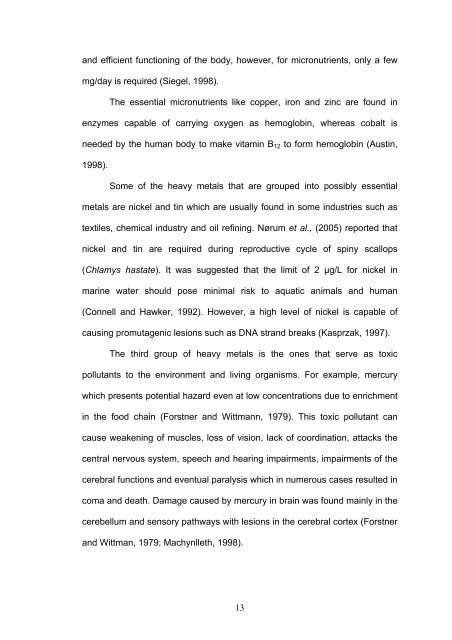IDENTIFICATION OF COPPER-INDUCIBLE GENES IN Pistia stratiotes
IDENTIFICATION OF COPPER-INDUCIBLE GENES IN Pistia stratiotes
IDENTIFICATION OF COPPER-INDUCIBLE GENES IN Pistia stratiotes
You also want an ePaper? Increase the reach of your titles
YUMPU automatically turns print PDFs into web optimized ePapers that Google loves.
and efficient functioning of the body, however, for micronutrients, only a few<br />
mg/day is required (Siegel, 1998).<br />
The essential micronutrients like copper, iron and zinc are found in<br />
enzymes capable of carrying oxygen as hemoglobin, whereas cobalt is<br />
needed by the human body to make vitamin B12 to form hemoglobin (Austin,<br />
1998).<br />
Some of the heavy metals that are grouped into possibly essential<br />
metals are nickel and tin which are usually found in some industries such as<br />
textiles, chemical industry and oil refining. Nørum et al., (2005) reported that<br />
nickel and tin are required during reproductive cycle of spiny scallops<br />
(Chlamys hastate). It was suggested that the limit of 2 µg/L for nickel in<br />
marine water should pose minimal risk to aquatic animals and human<br />
(Connell and Hawker, 1992). However, a high level of nickel is capable of<br />
causing promutagenic lesions such as DNA strand breaks (Kasprzak, 1997).<br />
The third group of heavy metals is the ones that serve as toxic<br />
pollutants to the environment and living organisms. For example, mercury<br />
which presents potential hazard even at low concentrations due to enrichment<br />
in the food chain (Forstner and Wittmann, 1979). This toxic pollutant can<br />
cause weakening of muscles, loss of vision, lack of coordination, attacks the<br />
central nervous system, speech and hearing impairments, impairments of the<br />
cerebral functions and eventual paralysis which in numerous cases resulted in<br />
coma and death. Damage caused by mercury in brain was found mainly in the<br />
cerebellum and sensory pathways with lesions in the cerebral cortex (Forstner<br />
and Wittman, 1979; Machynlleth, 1998).<br />
13








![[Consumer Behaviour] - ePrints@USM](https://img.yumpu.com/21924816/1/184x260/consumer-behaviour-eprintsusm.jpg?quality=85)








